Characteristics and Mechanical Properties of Graphene Nanoplatelets-Reinforced Epoxy Nanocomposites: Comparison of Different Dispersal Mechanisms
Abstract
1. Introduction
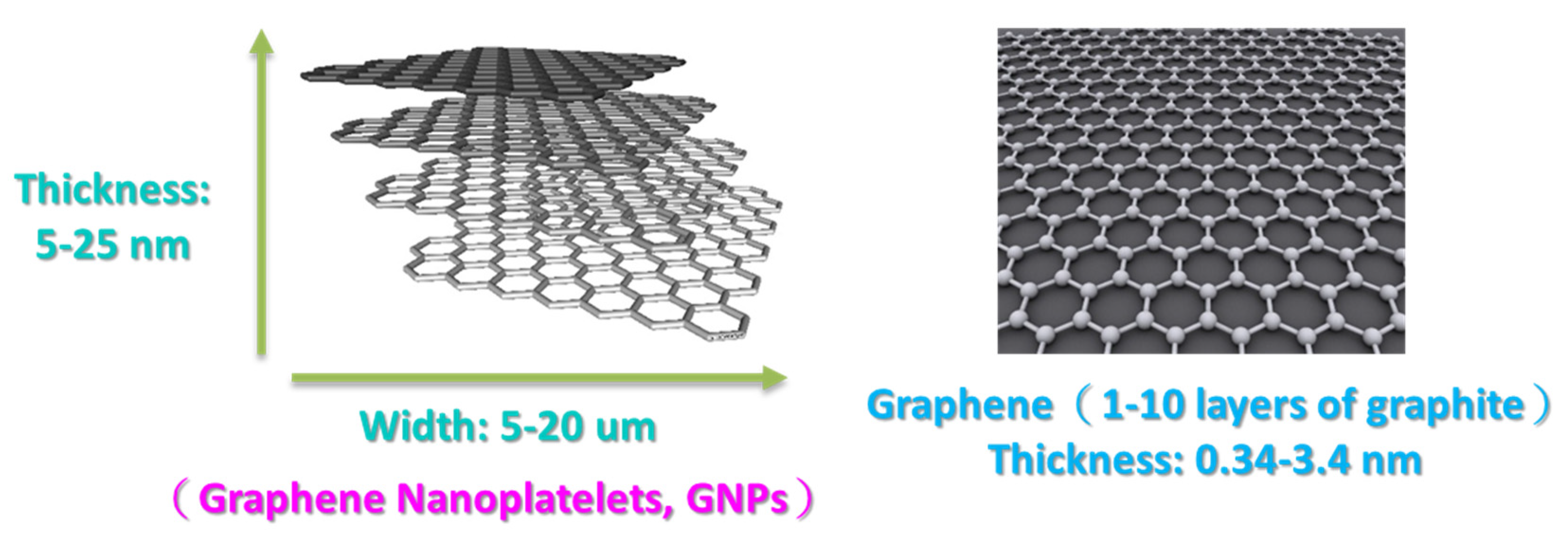
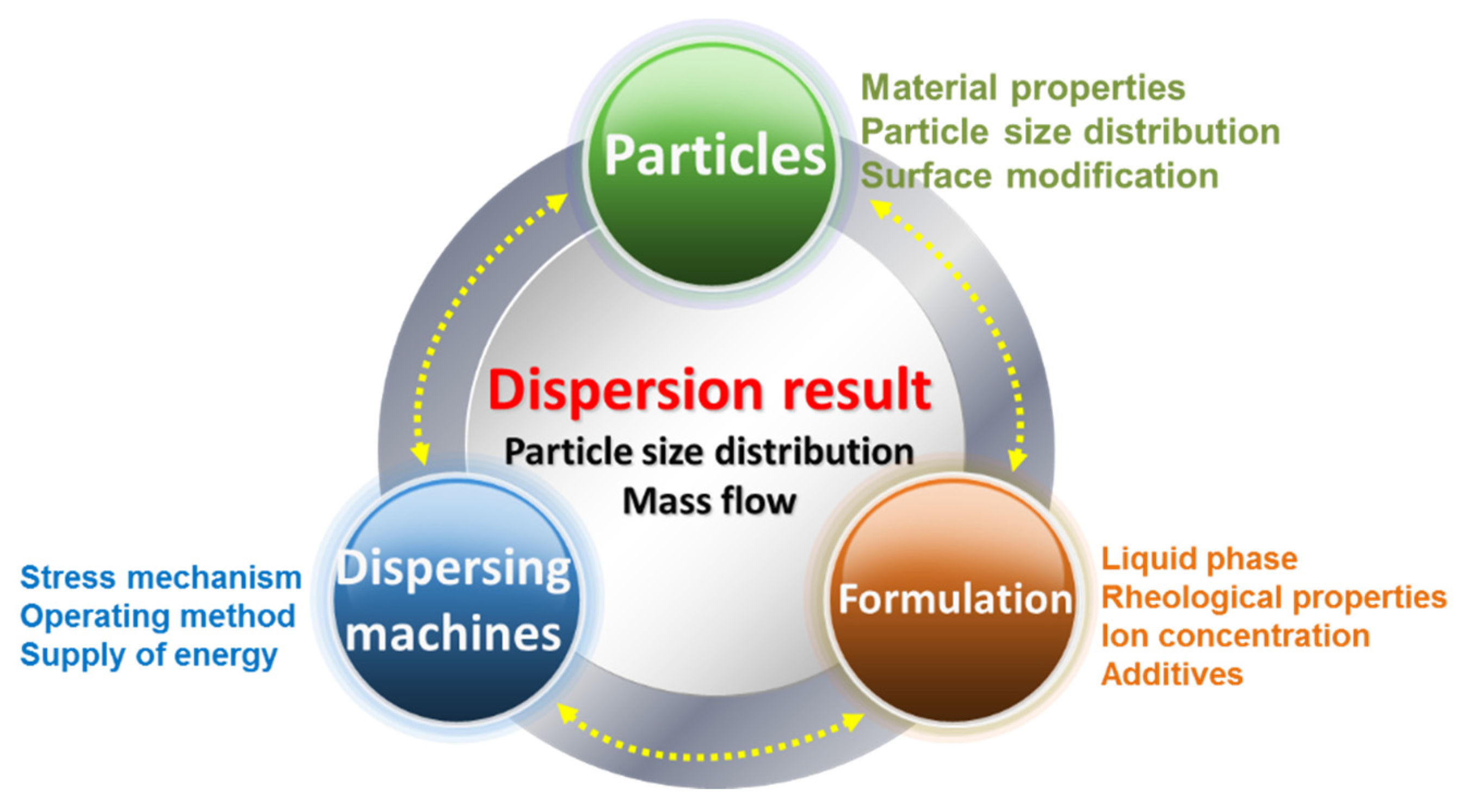
2. Materials and Methods
2.1. Nano-Carbon Materials
2.2. Preparation of GNP/Epoxy Resin Nanocomposites
2.2.1. Preparation of GNP/Epoxy Resin Solution Using Planetary Centrifugal Mixing
2.2.2. Preparation of GNP/Epoxy Resin Solution by Three-Roll Milling (TRM)
2.2.3. Preparation of GNP/Epoxy Nanocomposites
2.3. Test Methods
2.3.1. Tensile Test
2.3.2. Flexural Test
2.3.3. Viscosity Test
3. Results and Discussion
3.1. Mechanical Properties of GNP/Epoxy Nanocomposites Prepared Using Planetary Centrifugal Mixing
3.2. Mechanical Properties of GNP/Epoxy Nanocomposites Prepared Using Different Methods of Dispersal
3.3. Morphology of GNP/Epoxy Nanocomposites
4. Conclusions
Author Contributions
Funding
Institutional Review Board Statement
Informed Consent Statement
Data Availability Statement
Acknowledgments
Conflicts of Interest
References
- Sharma, V.K.; McDonald, T.J.; Kim, H.; Garg, V.K. Magnetic graphene-carbon nanotube iron nanocomposites as adsorbents and antibacterial agents for water purification. Adv. Colloid Interface Sci. 2015, 225, 229–240. [Google Scholar] [CrossRef]
- Li, J.; Kim, J.K. Percolation threshold of conducting polymer composites containing 3D randomly distributed graphite nanoplatelets. Compos. Sci. Technol. 2007, 67, 2114–2120. [Google Scholar] [CrossRef]
- Weng, W.G.; Chen, G.H.; Wu, D.J.; Yan, W.L. HDPE/expanded graphite electrically conducting composite. Compos. Interf. 2004, 11, 131–143. [Google Scholar] [CrossRef]
- Chen, G.H.; Wu, D.J.; Weng, W.G.; Yan, W.L. Preparation of polymer/graphite conducting nanocomposite by intercalation polymerization. J. Appl. Polym. Sci. 2001, 82, 2506–2513. [Google Scholar] [CrossRef]
- Zheng, W.; Wong, S.C. Electrical conductivity and dielectric properties of PMMA/expanded graphite composites. Compos. Sci. Technol. 2003, 63, 225–235. [Google Scholar] [CrossRef]
- Chen, X.M.; Shen, J.W.; Huang, W.Y. Novel electrically conductive polypropylene/graphite nanocomposites. J. Mater. Sci. Lett. 2002, 21, 213–214. [Google Scholar] [CrossRef]
- Yao, H.; Hawkins, S.A.; Sue, H.J. Preparation of epoxy nanocomposites containing well-dispersed graphene nanosheets. Compos. Sci. Technol. 2017, 146, 161–168. [Google Scholar] [CrossRef]
- Li, A.; Zhang, C.; Zhang, Y.F. Graphene nanosheets-filled epoxy composites prepared by a fast dispersion method. J. Appl. Polym. Sci. 2017, 134, 45152. [Google Scholar] [CrossRef]
- Si, Y.; Samulski, E.T. Exfoliated graphene separated by platinum nanoparticles. Chem. Mater. 2008, 20, 6792–6797. [Google Scholar] [CrossRef]
- Si, Y.; Samulski, E.T. Synthesis of water soluble graphene. Nano. Lett. 2008, 8, 1679–1682. [Google Scholar] [CrossRef] [PubMed]
- Li, D.; Muller, M.B.; Gilje, S.; Kaner, R.B.; Wallace, G.G. Processable aqueous dispersions of graphene nanosheets. Nat. Nanotechnol. 2008, 3, 101–105. [Google Scholar] [CrossRef]
- Ram, A. Fundamentals of Polymer Engineering; Springer: New York, NY, USA, 1997. [Google Scholar]
- Kinloch, A.J. Adhesion and Adhesives: Science and Technology, 1st ed.; Chapman and Hall: London, UK, 1987. [Google Scholar]
- Kinloch, A.J.; Lee, S.H.; Taylor, A.C. Improving the fracture toughness and the cyclicfatigue resistance of epoxy-polymer blends. Polymer 2014, 55, 6325–6334. [Google Scholar] [CrossRef]
- Schueler, R.; Petermann, J.; Schulte, K.; Wentzel, H.P. Agglomeration and electrical percolation behavior of carbon black dispersed in epoxy resin. J. Appl. Polym. Sci. 1997, 63, 1741–1746. [Google Scholar] [CrossRef]
- Lan, T.; Pinnavaia, T.J. Clay-reinforced epoxy nanocomposites. Chem. Mater. 1994, 6, 2216–2219. [Google Scholar] [CrossRef]
- Johnsen, B.B.; Kinloch, A.J.; Mohammed, R.D.; Taylor, A.C.; Sprenger, S. Toughening mechanisms of nanoparticle-modified epoxy polymers. Polymer 2007, 48, 530–541. [Google Scholar] [CrossRef]
- Ajayan, P.M.; Schadler, L.S.; Giannaris, C.; Rubio, A. Single-walled carbon nanotubepolymer composites: Strength and weakness. Adv. Mater. 2000, 12, 750–753. [Google Scholar] [CrossRef]
- Shen, M.Y.; Chang, T.Y.; Hsieh, T.H.; Li, Y.L.; Chiang, C.L.; Yang, H.; Yip, M.C. Mechanical Properties and Tensile Fatigue of Graphene Nanoplatelets Reinforced Polymer Nanocomposites. J. Nanomater. 2013, 565401. [Google Scholar] [CrossRef]
- Wang, P.N.; Hsieh, T.H.; Chiang, C.-L.; Shen, M.Y. Synergetic effects of mechanical properties on Graphene nanoplatelet and Multiwalled Carbon Nanotube Hybrids Reinforced Epoxy/Carbon Fiber Composites. J. Nanomater. 2015, 838032. [Google Scholar] [CrossRef]
- Hsieh, T.H.; Huang, Y.S.; Shen, M.Y. Carbon Nanotube Size Effect on the Mechanical Properties and Toughness of Nanocomposites. Polym. Compos. 2017, 39, E1072–E1086. [Google Scholar] [CrossRef]
- Hsieh, T.H.; Chen, W.J.; Chiang, C.-L.; Shen, M.Y. Environmental aging effect on interlaminar properties of graphene nanoplatelets reinforced epoxy/carbon fiber composite laminates. J. Reinf. Plast. Comp. 2018, 37, 1177–1190. [Google Scholar] [CrossRef]
- Kuan, C.F.; Chiang, C.-L.; Lin, S.H.; Huang, W.G.; Hsieh, W.Y.; Shen, M.Y. Characterization and Properties of Graphene Nanoplatelets/XNBR Nanocomposites. Polym. Polym. Compos. 2018, 26, 59–67. [Google Scholar] [CrossRef]
- Zhang, X.C.; Peng, H.X.; Limmack, A.P.; Scarpa, F. Viscoelastic damping behaviour of cup stacked carbon nanotube modified epoxy nanocomposites with tailored interfacial condition and re-agglomeration. Compos. Sci. Technol. 2014, 105, 66–72. [Google Scholar] [CrossRef]
- Wang, Y.; Zhang, J.; Shen, X.; Shi, C.; Wu, J.; Sun, L. Dispersion investigation of TiO2 nanoparticles coated by pulsed RF plasma polymer. Mater. Chem. Phys. 2006, 98, 217–224. [Google Scholar] [CrossRef]
- Schilde, C.; Nolte, H.; Arlt, C.; Kwade, A. Effect of fluid–particle-interactions on dispersing nano-particles in epoxy resins using stirred-media-mills and three-roll-mills. Compos. Sci. Technol. 2010, 70, 657–663. [Google Scholar] [CrossRef]
- Suihkonen, R.; Nevalainen, K.; Orell, O.; Honkanen, M.; Tang, L.; Zhang, H.; Zhang, Z.; Vuorinen, J. Performance of epoxy filled with nano- and micro-sized Magnesium hydroxide. J. Mater. Sci. 2012, 47, 1480–1488. [Google Scholar] [CrossRef]
- Yasmin, A.; Luo, J.J.; Abot, J.L.; Daniel, I.M. Processing of expanded graphite reinforced polymer nanocomposites. Compos. Sci. Technol. 2006, 66, 1182–1189. [Google Scholar] [CrossRef]
- Prolongo, S.G.; Moriche, R.; Jiménez-Suárez, A.; Sánchez, M.; Ureña, A. Advantages and disadvantages of the addition of graphene nanoplatelets to epoxy resins. Eur. Polym. J. 2014, 61, 206–214. [Google Scholar] [CrossRef]
- Ahmadi-Moghadam, B.; Taheri, F. Fracture and toughening mechanisms of GNP-based nanocomposites in modes I and II fracture. Eng. Fract. Mech. 2014, 131, 329–339. [Google Scholar] [CrossRef]
- Chandrasekaran, S.; Sato, N.; Tolle, F.; Mulhaupt, R.; Fiedler, B.; Schulte, K. Fracture toughness and failure mechanism of graphene based epoxy composites. Compos. Sci. Technol. 2014, 97, 90–99. [Google Scholar] [CrossRef]
- Mannov, E.; Schmutzler, H.; Chandrasekaran, S.; Viets, C.; Buschhorn, S.; Tolle, F.; Mulhaupt, R.; Schulte, K. Improvement of compressive strength after impact in fibre reinforced polymer composites by matrix modification with thermally reduced graphene oxide. Compos. Sci. Technol. 2013, 87, 36–41. [Google Scholar] [CrossRef]
- Prolongo, S.G.; Jimenez-Suarez, S.; Moriche, R.; Urena, A. In situ processing of epoxy composites reinforced with graphene nanoplatelets. Compos. Sci. Technol. 2013, 86, 185–191. [Google Scholar] [CrossRef]
- Kostagiannakopoulou, C.; Loutas, T.H.; Sotiriadis, G.; Markou, A.; Kostopoulos, V. On the interlaminar fracture toughness of carbon fiber composites enhanced with graphene nano-species. Compos. Sci. Technol. 2015, 118, 217–225. [Google Scholar] [CrossRef]
- Chatterjee, S.; Nafezarefi, F.; Tai, N.H.; Schlagenhauf, L.; Nüesch, F.A.; Chu, B.T.T. Size and synergy effects of nanofiller hybrids including graphene nanoplatelets and carbon nanotubes in mechanical properties of epoxy composites. Carbon 2012, 50, 380–5386. [Google Scholar] [CrossRef]
- Bridgwater, J. Mixing of powders and granular materials by mechanical means—A perspective. Particuology 2012, 10, 397–427. [Google Scholar] [CrossRef]
- Park, Y.M.; Lee, D.H.; Hwang, W.R.; Lee, S.B.; Jung, S.I. Hydrodynamics of CNT dispersion in high shear dispersion mixers. Korea-Aust. Rheol. J. 2014, 26, 347–353. [Google Scholar] [CrossRef]
- Takatsuka, T.; Endo, T.; Jianguo, Y.; Yuminoki, K.; Hashimoto, N. Nanosizing of poorly water soluble compounds using rotation/revolution mixer. Chem. Pharm. Bull. 2009, 57, 1061–1067. [Google Scholar] [CrossRef]
- Tsuchiya, K.; Sakai, A.; Nagaoka, T.; Uchida, K.; Furukawa, T.; Yajima, H. High electrical performance of carbon nanotubes/rubber composites with low percolation threshold prepared with a rotation-revolution mixing technique. Compos. Sci. Technol. 2011, 71, 1098–1104. [Google Scholar] [CrossRef]
- Mizuuchi, K.; Inoue, K.; Agari, Y.; Sugioka, M.; Tanaka, M.; Takeuchi, T.; Kawahara, M.; Makino, Y.; Ito, M. Processing of diamond-particle-dispersed silver-matrix composites in solid-liquid co-existent state by SPS and their thermal conductivity. Compos. B Eng. 2012, 43, 1445–1452. [Google Scholar] [CrossRef]
- Galpaya, D.; Wang, M.; George, G.; Motta, N.; Waclawik, E.; Yan, C. Preparation of graphene oxide/epoxy nanocomposites with significantly improved mechanical properties. J. Appl. Phys. 2014, 116, 053518. [Google Scholar] [CrossRef]
- Cha, J.; Jun, G.H.; Park, J.K.; Kim, J.C.; Ryu, H.J.; Hong, S.H. Improvement of modulus, strength and fracture toughness of CNT/Epoxy nanocomposites through the functionalization of carbon nanotubes. Compos. B Eng. 2017, 129, 169–179. [Google Scholar] [CrossRef]
- Cha, J.; Kim, J.; Ryu, S.; Hong, S.H. Comparison to mechanical properties of epoxy nanocomposites reinforced by functionalized carbon nanotubes and graphene nanoplatelets. Compos. B Eng. 2019, 162, 283–288. [Google Scholar] [CrossRef]
- Chiang, C.-L.; Yeh, Y.L.; Hsu, C.W.; Shen, M.Y. Dispersion Technology on Mechanical Properties of Carbon nanomaterials Reinforced Epoxy Nanocomposites. Mod. Phys. Lett. B 2020, 34, 2040019. [Google Scholar] [CrossRef]
- Kim, S.H.; Kim, S.J.; Park, S.J.; Mun, J.H.; Kang, T.G.; Park, J.M. Rheological behavior of magnetic powder mixtures for magnetic PIM. Korea-Aust. Rheol. J. 2012, 24, 121–127. [Google Scholar] [CrossRef]
- Park, J.M.; Park, S.J. Rheology and processing of suspensions with fiber, disk and magnetic particles. Korea-Aust. Rheol. J. 2011, 23, 219–226. [Google Scholar] [CrossRef]
- Son, K.J. A discrete element model for the influence of surfactants on sedimentation characteristics of magnetorheological fluids. Korea-Aust. Rheol. J. 2018, 30, 29–39. [Google Scholar] [CrossRef]
- Graphene-Wikipedia. Available online: https://en.wikipedia.org/wiki/Graphene (accessed on 20 January 2021).
- Heidenreich, R.D.; Hess, W.M.; Ban, L.L. A test object and criteria for high resolution electron microscopy. J. Appl. Crystallogr. 1968, 1, 1–19. [Google Scholar] [CrossRef]
- Gojny, F.H.; Wichmann, M.H.G.; Köpke, U.; Fiedler, B.; Schulte, K. Carbon nanotube-reinforced epoxy-composites: Enhanced stiffness and fracture toughness at low nanotube content. Compos. Sci. Technol. 2004, 64, 2363–2371. [Google Scholar] [CrossRef]
- Chen, X.; Dobson, J.F.; Raston, C.L. Vortex fluidic exfoliation of graphite and boron nitride. Chem. Commun. 2012, 48, 3703–3705. [Google Scholar] [CrossRef] [PubMed]

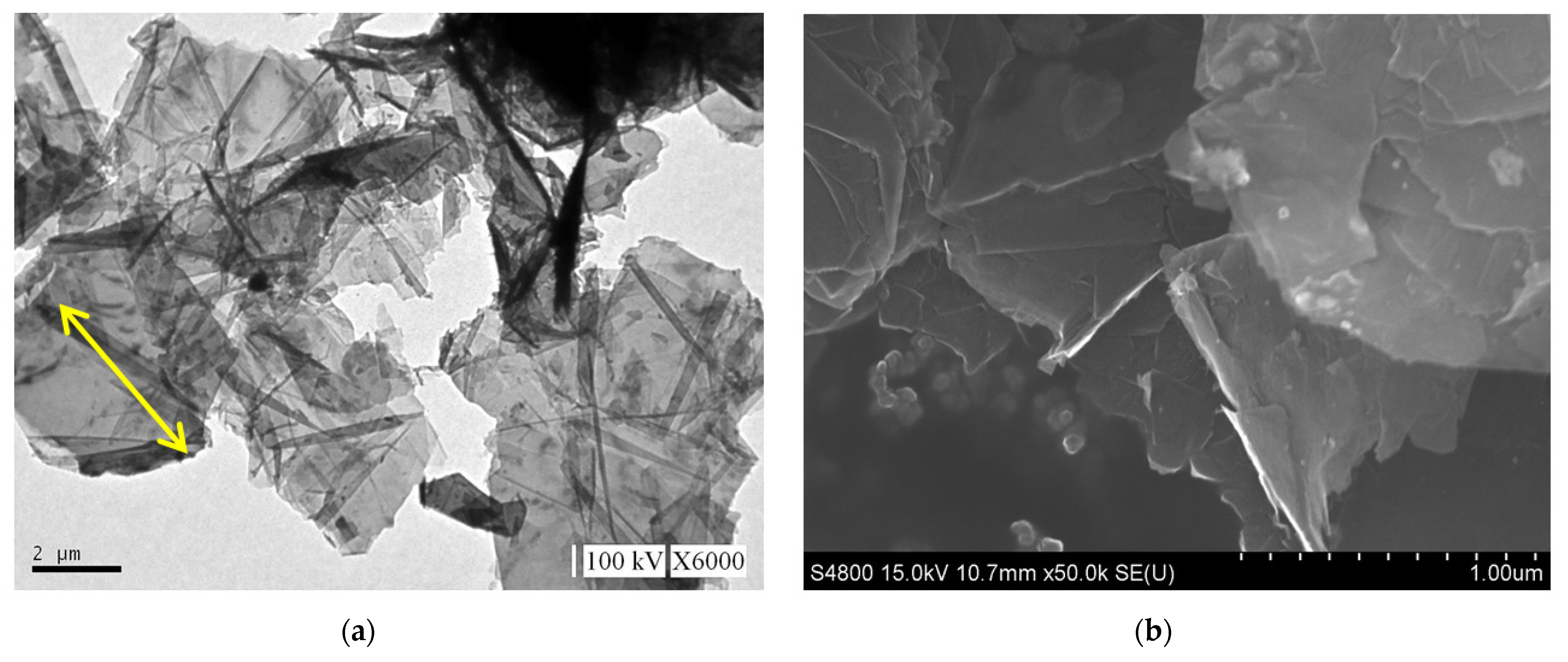
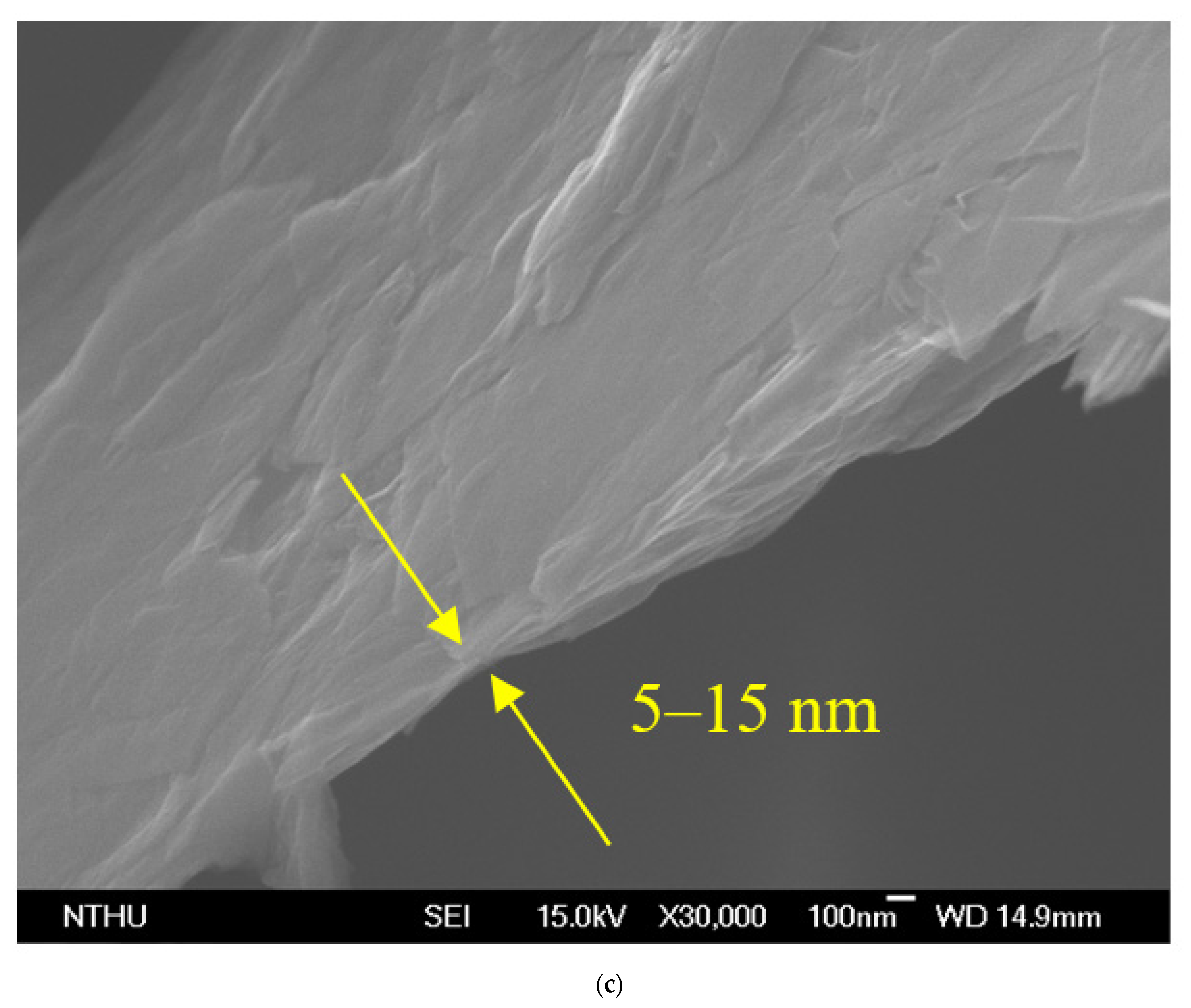


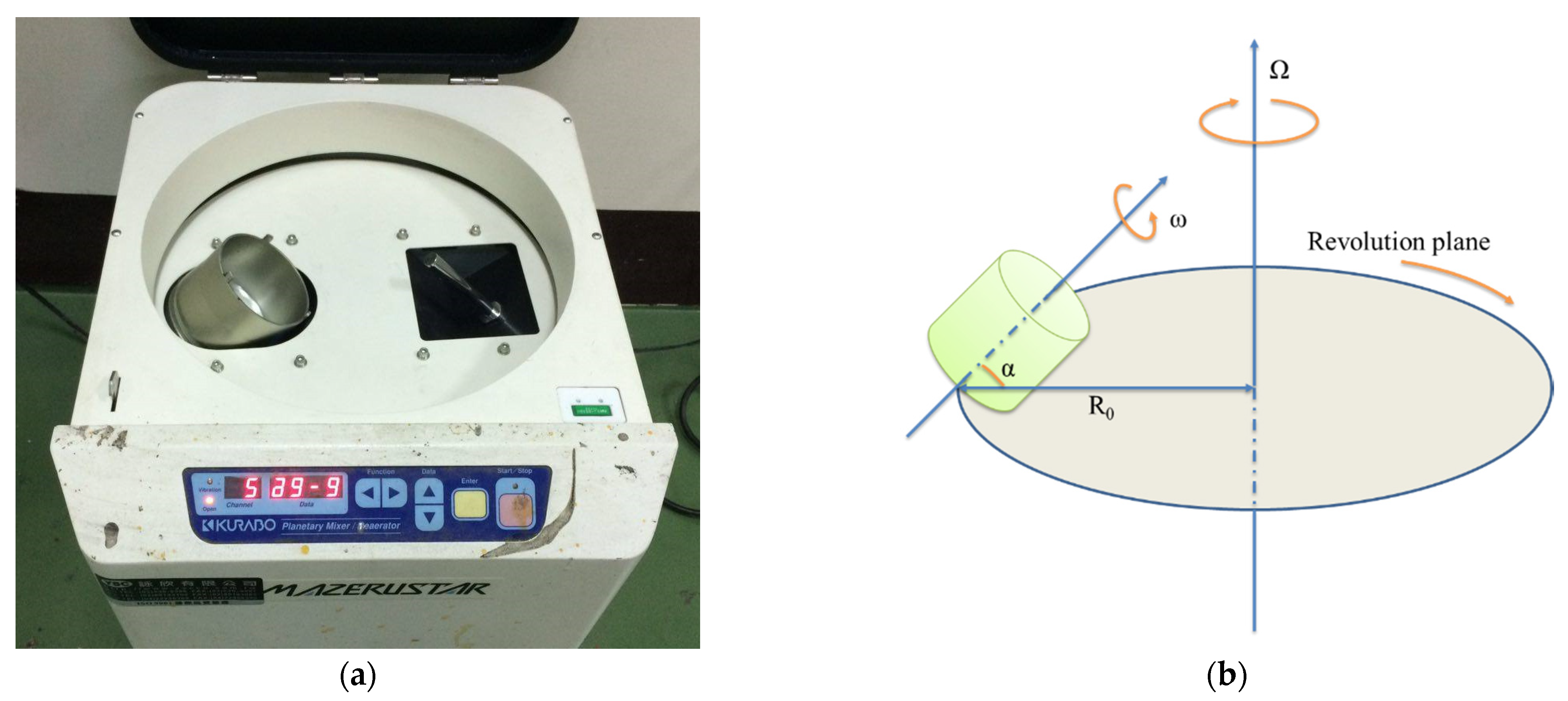
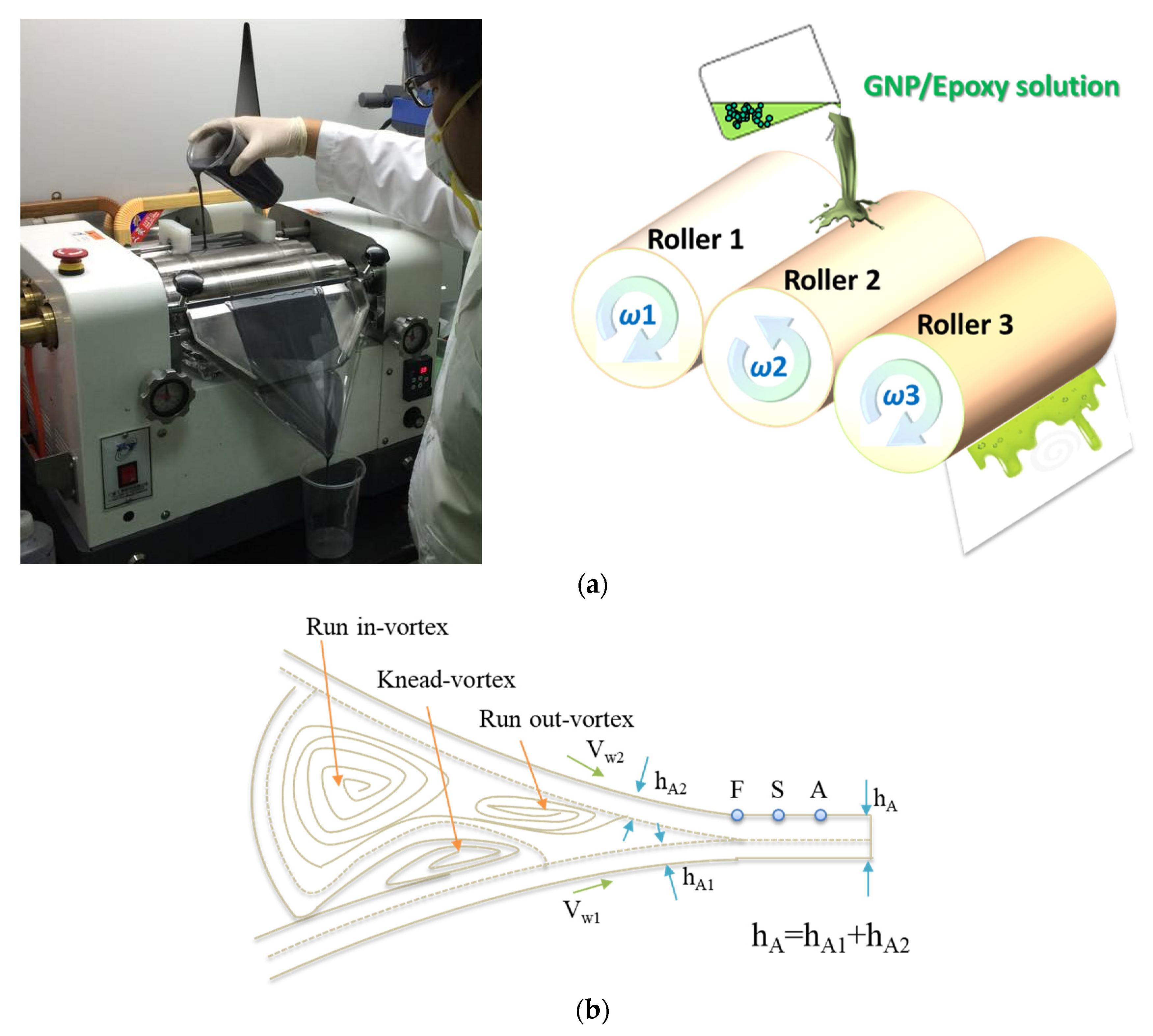
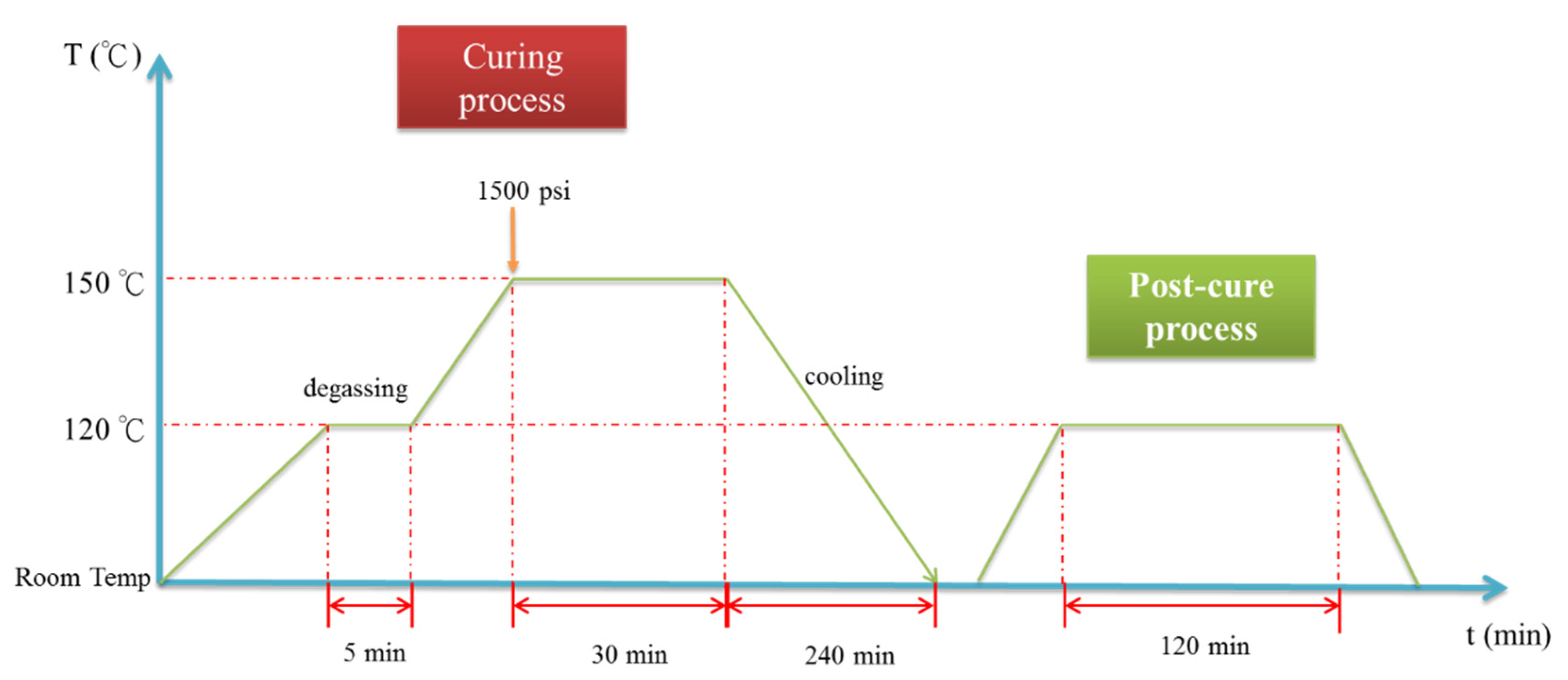
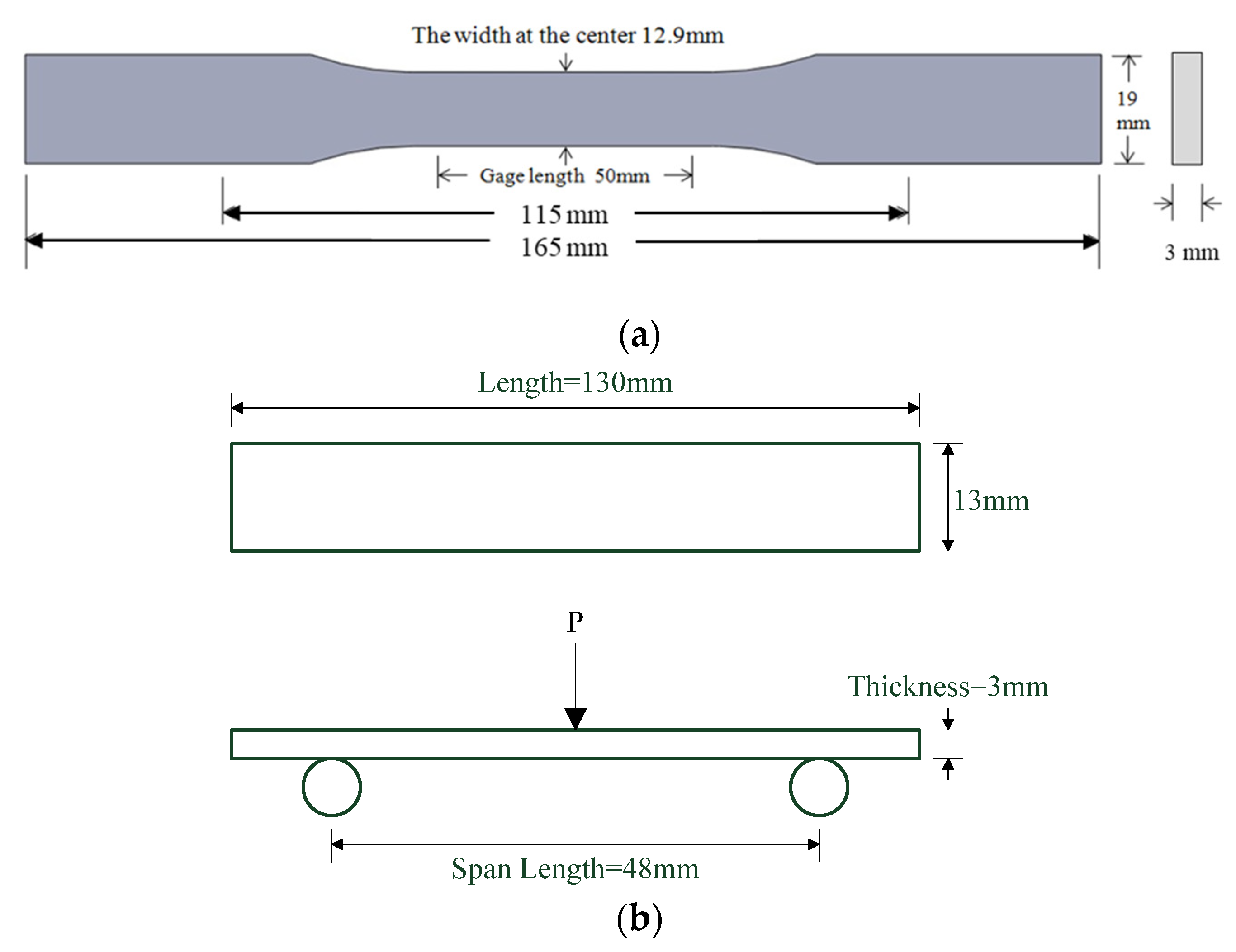
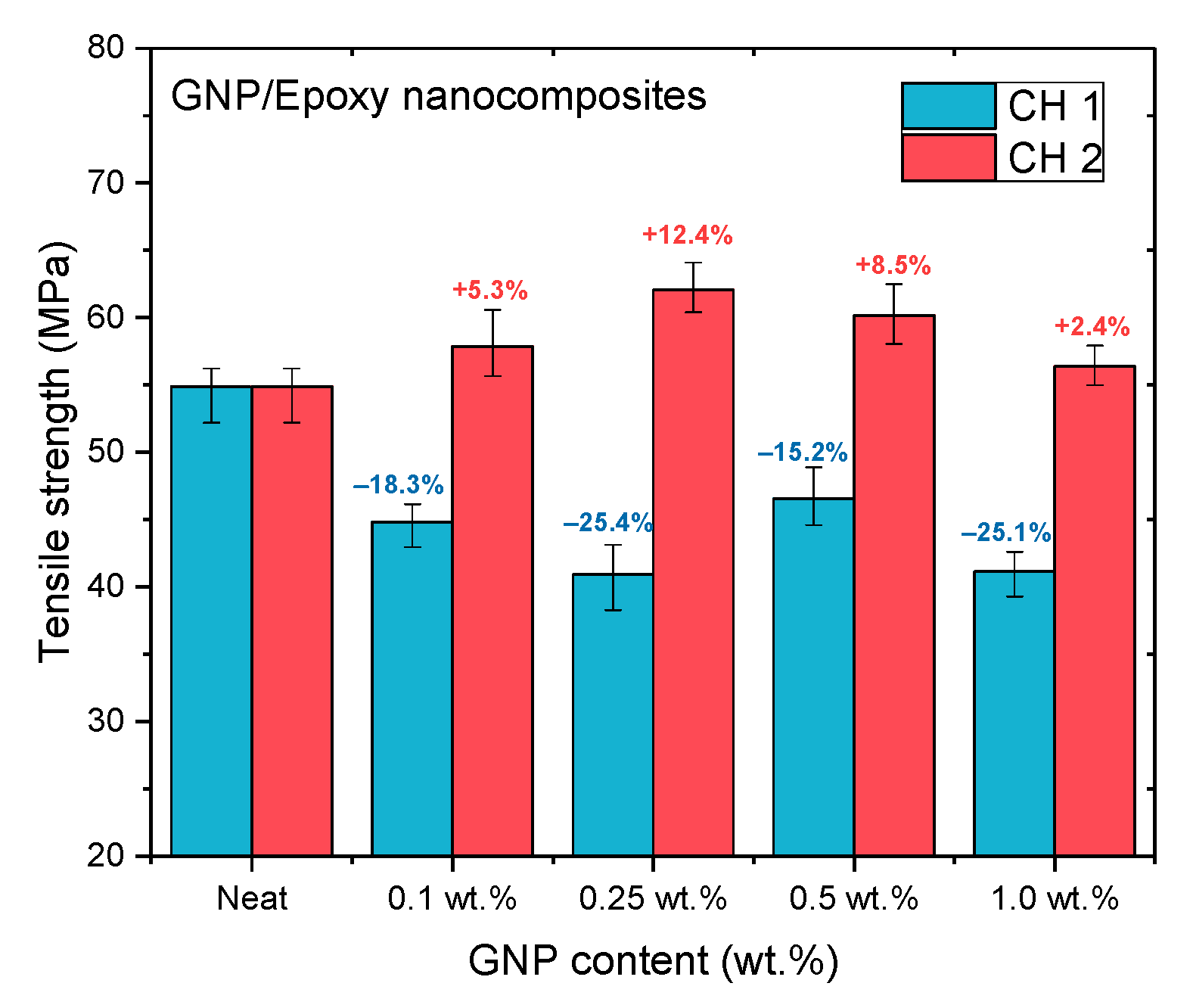
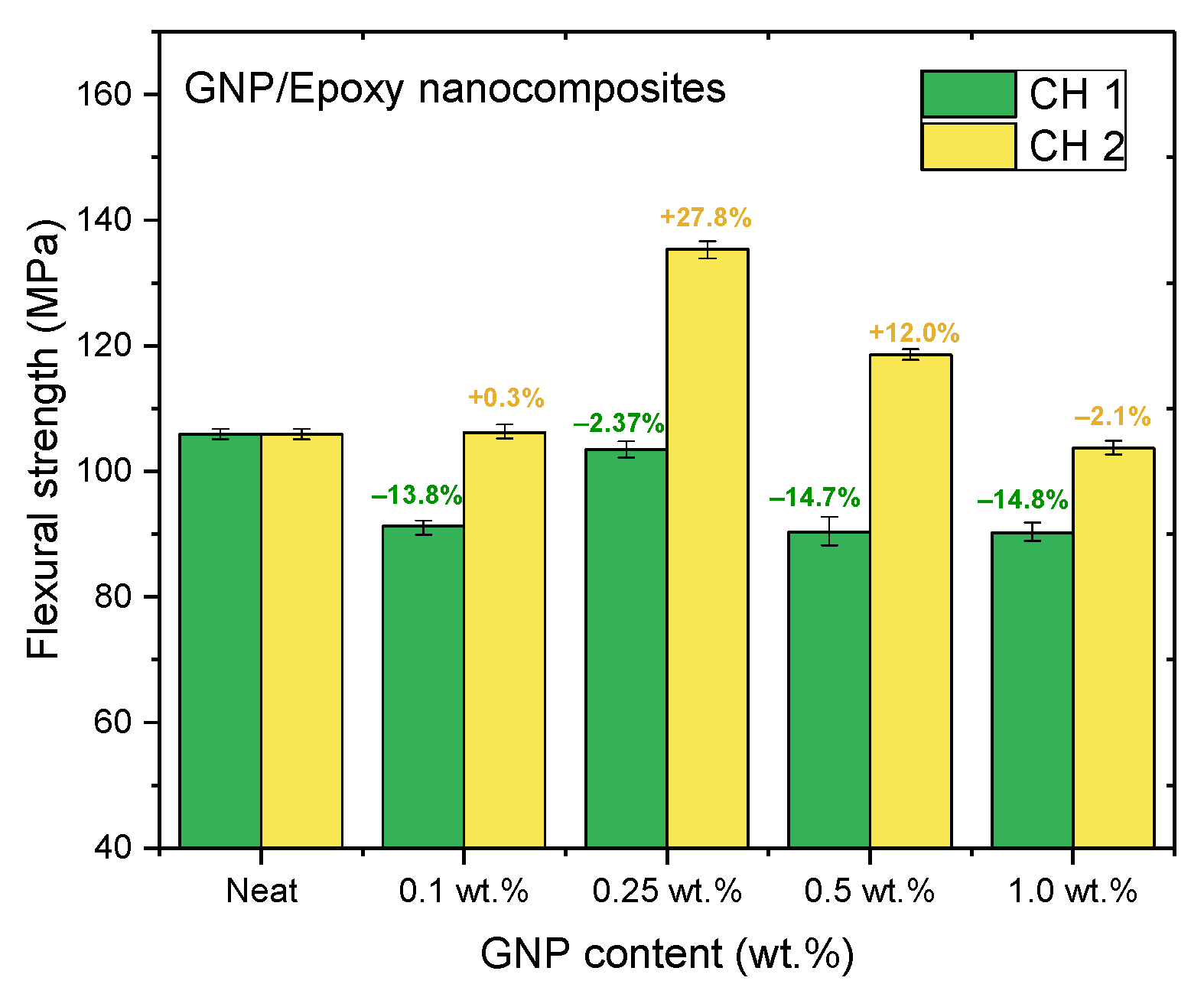
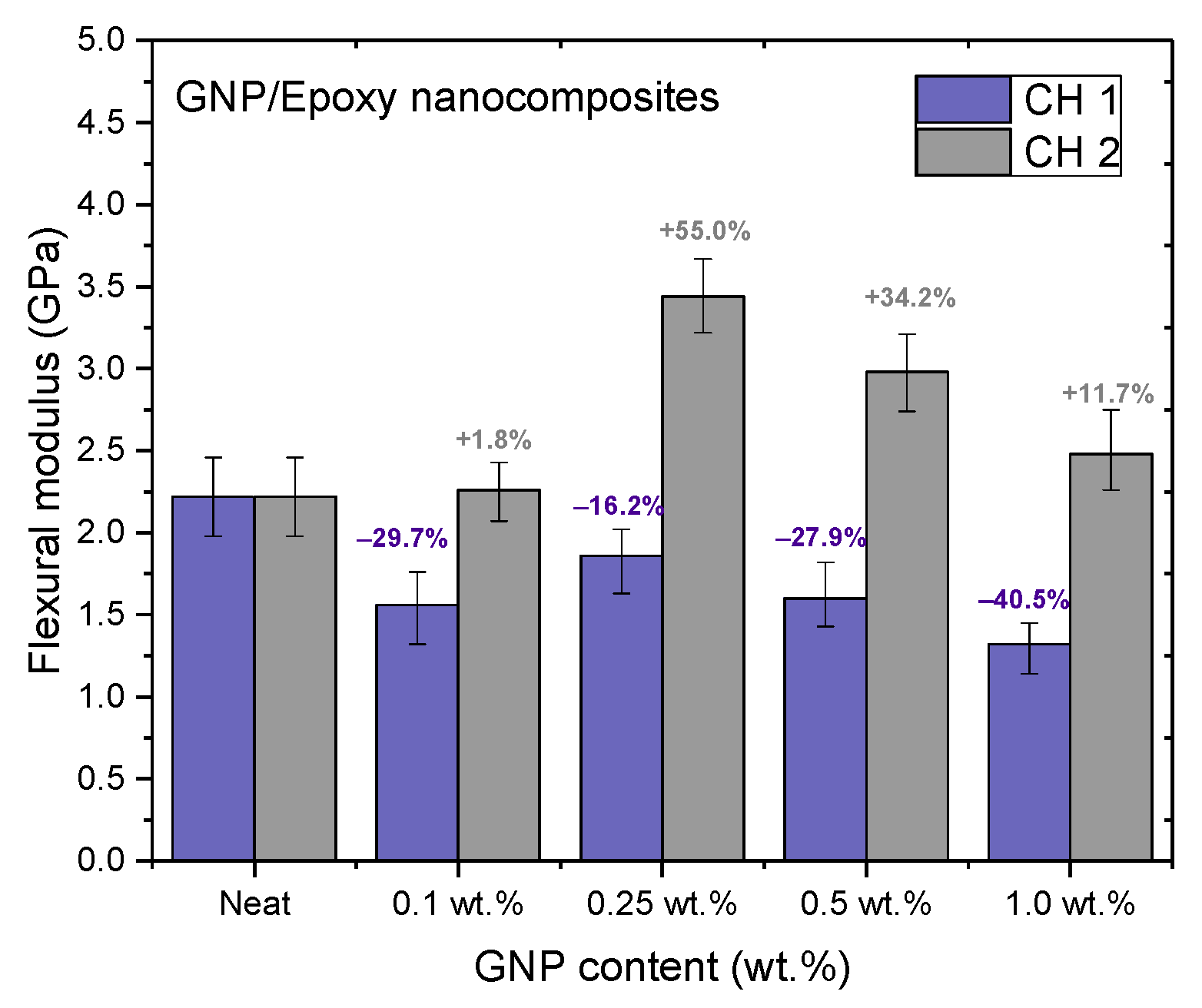
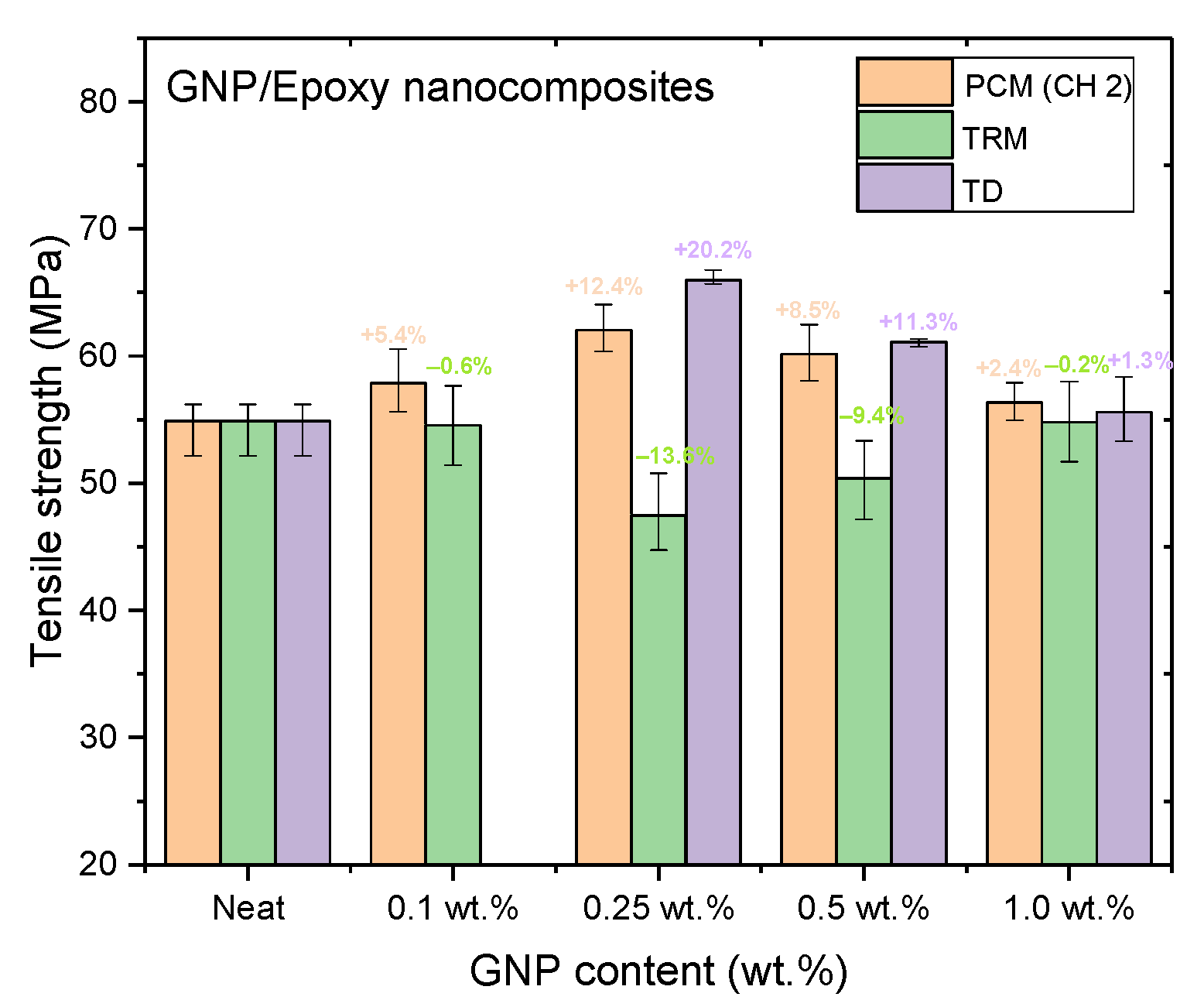
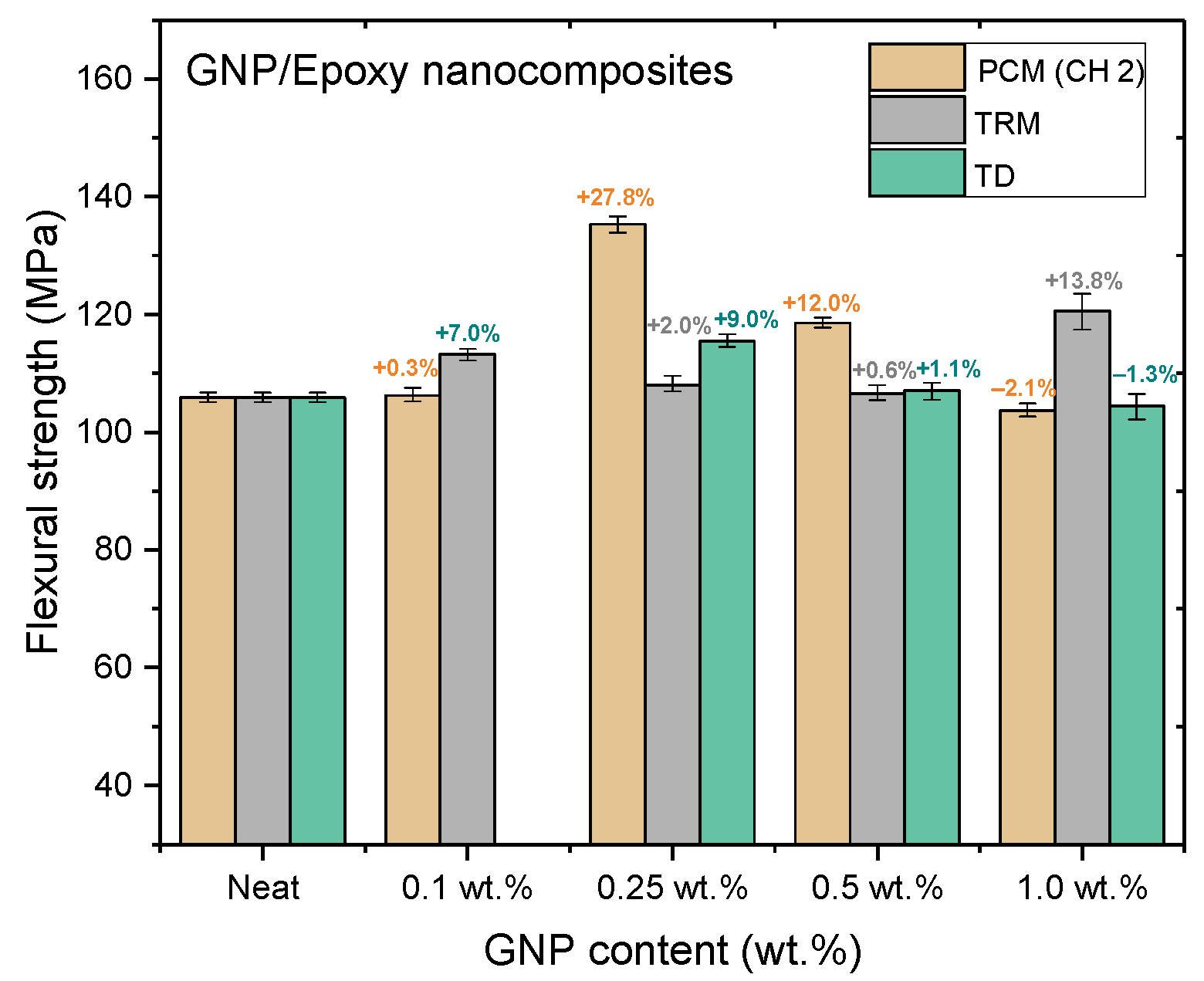

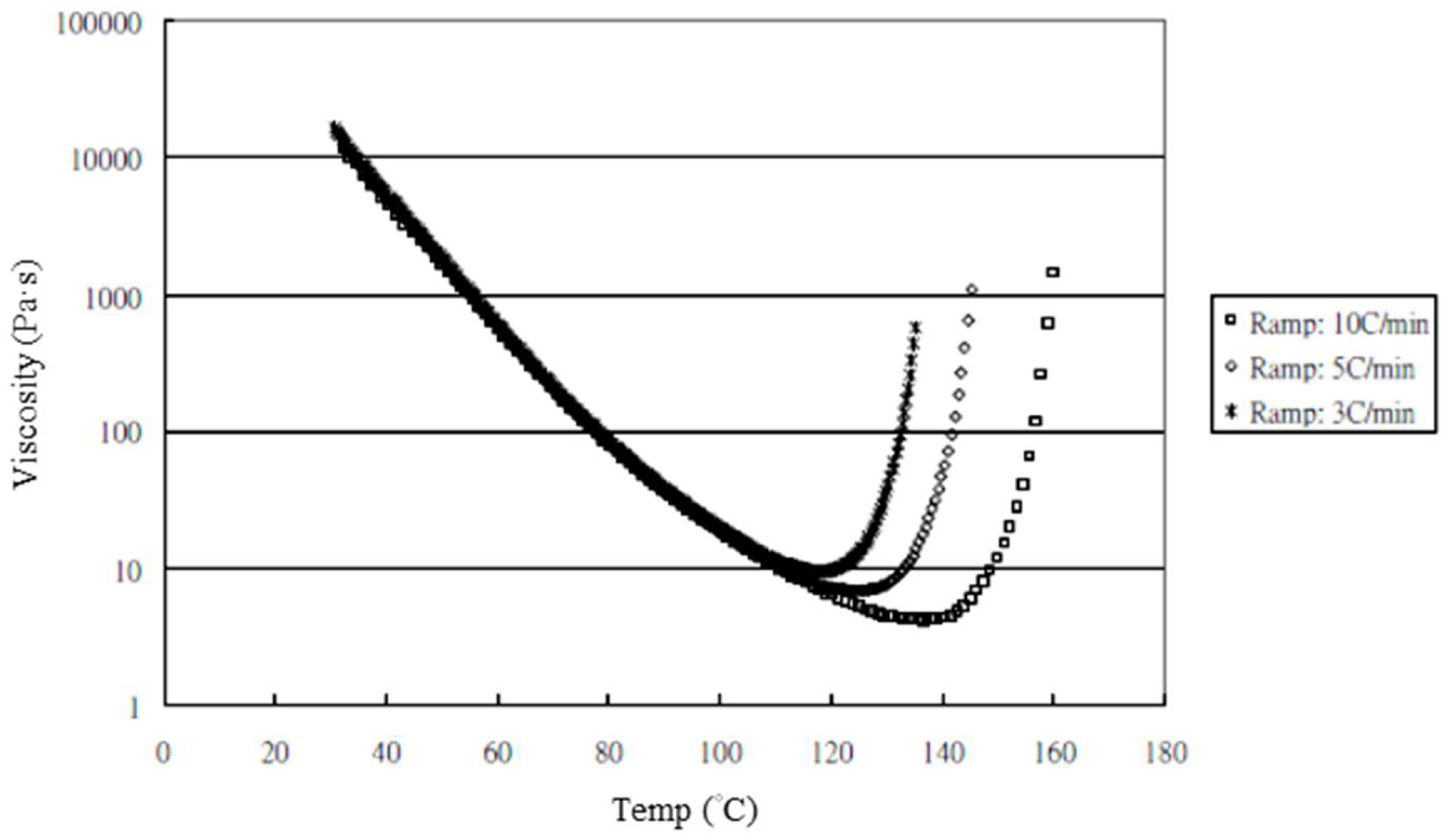
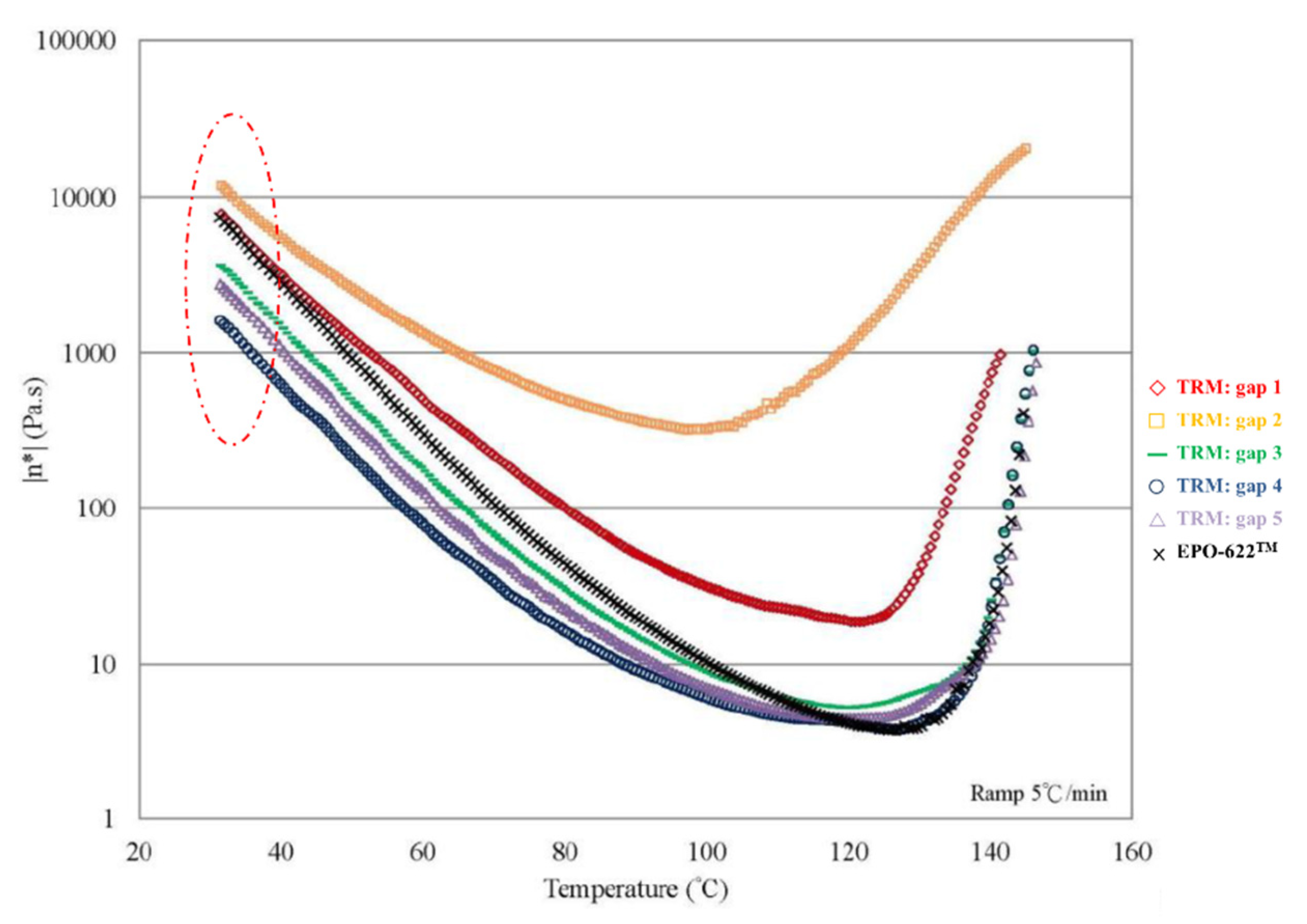

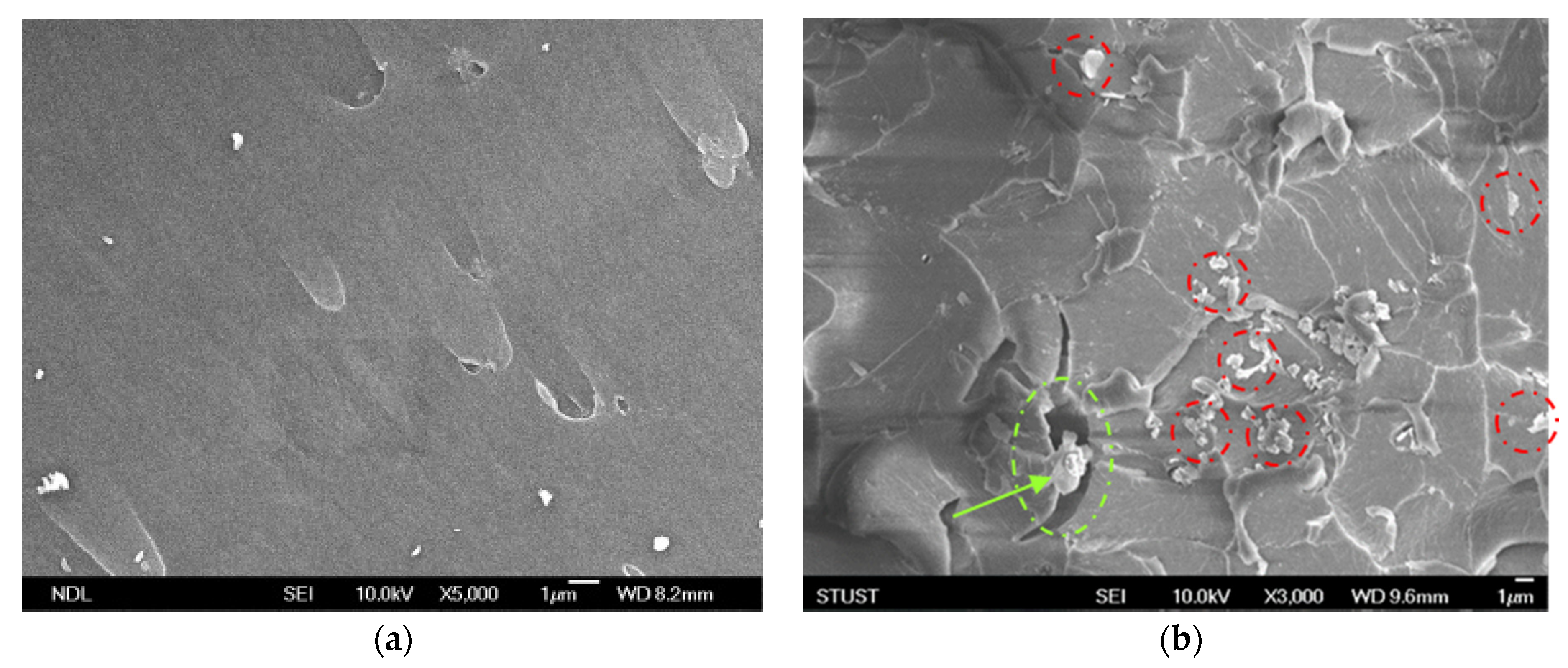
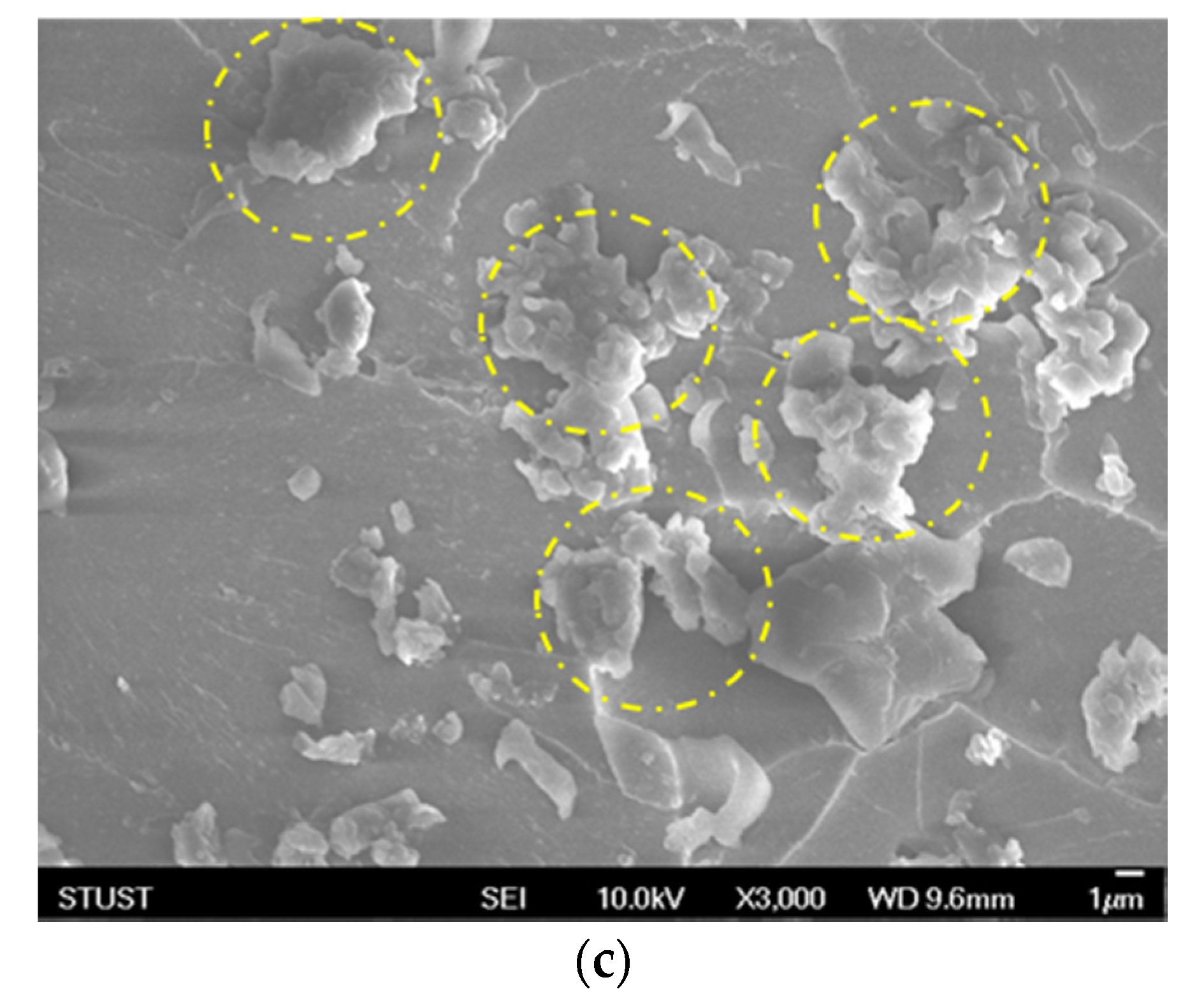
| Channel | Step | Function | Application | |||||
|---|---|---|---|---|---|---|---|---|
| Rev (rpm) | Rot (rpm) | Time (min) | Mixing | Deaerating | Speed | Temperature-Rise Control | ||
| CH 1 | 1200 | 500 | 20 | ○ | ○ | ○ | ○ | Standard mixing/deaerating |
| CH 2 | 1600 | 1600 | 20 | ◎ | ✕ | ◎ | ✕ | Mixing priority |
| Unit | Channel | GNP Content (wt.%) | ||||
|---|---|---|---|---|---|---|
| Neat | 0.1 | 0.25 | 0.5 | 1.0 | ||
| Tensile strength (MPa) | CH 1 | 54.89 | 50.82 | 53.87 | 60.21 | 53.02 |
| CH 2 | 44.82 | 40.93 | 46.57 | 41.14 | ||
| Flexural strength (MPa) | CH 1 | 105.89 | 105.00 | 107.67 | 122.57 | 124.56 |
| CH 2 | 109.29 | 92.77 | 82.89 | 103.91 | ||
| Flexural modulus (GPa) | CH 1 | 2.22 | 2.30 | 2.82 | 2.94 | 3.19 |
| CH 2 | 1.56 | 1.86 | 1.60 | 1.32 | ||
| Process (MPa) | GNP Content (wt.%) | ||||
|---|---|---|---|---|---|
| Neat | 0.1 | 0.25 | 0.5 | 1.0 | |
| PCM (CH 2) | 54.89 | 57.87 | 62.05 | 60.17 | 56.36 |
| % Enhancement | +5.4 | +12.4 | +8.5 | +2.44 | |
| TRM | 54.57 | 47.46 | 50.41 | 54.79 | |
| % Enhancement | −0.6 | −13.6 | −9.4 | −0.2 | |
| TM | - | 66 | 61.11 | 55.59 | |
| % Enhancement | - | +20.2 | +11.3 | +1.3 | |
| Process (MPa) | GNP Content (wt.%) | ||||
|---|---|---|---|---|---|
| Neat | 0.1 | 0.25 | 0.5 | 1.0 | |
| PCM (CH 2) | 105.89 | 106.21 | 135.35 | 118.57 | 103.66 |
| % Enhancement | +0.3 | +27.8 | +12.0 | −2.1 | |
| TRM | 113.27 | 108 | 106.55 | 120.54 | |
| % Enhancement | +7.0 | +2.0 | +0.6 | +13.8 | |
| TM | - | 115.46 | 107.07 | 104.48 | |
| % Enhancement | - | +9.0 | +11.3 | +1.3 | |
| Process (GPa) | GNP Content (wt.%) | ||||
|---|---|---|---|---|---|
| Neat | 0.1 | 0.25 | 0.5 | 1.0 | |
| PCM (CH 2) | 2.22 | 2.26 | 3.44 | 2.98 | 2.48 |
| % Enhancement | +1.8 | +55.0 | +34.2 | +11.7 | |
| TRM | 2.27 | 2.67 | 2.77 | 2.85 | |
| % Enhancement | +2.3 | +20.3 | +24.8 | +28.4 | |
| TM | - | 2.49 | 2.50 | 2.53 | |
| % Enhancement | - | +12.2 | +12.6 | +14.0 | |
| Processes (Min) | Homogenizer Stirring | Ultrasonication | Mechanical Mixer | Planetary Centrifugal Mixer | Three-Roll Milling | Total Dispersion Time |
|---|---|---|---|---|---|---|
| PCM | 30 | 20 | 50 | |||
| TRM | 30 | 100 | 130 | |||
| TD | 10 | 90 | 90 | 190 |
| Ramp 5 °C/min | EPO-622TM | TRM | ||||
|---|---|---|---|---|---|---|
| Gap 1 | Gap 2 | Gap 3 | Gap 4 | Gap 5 | ||
| @30 °C, Viscosity (Pa·s) | 8.6 × 103 | 9.2 × 103 | 1.4 × 104 | 4.2 × 103 | 1.9 × 103 | 3.1 × 103 |
Publisher’s Note: MDPI stays neutral with regard to jurisdictional claims in published maps and institutional affiliations. |
© 2021 by the authors. Licensee MDPI, Basel, Switzerland. This article is an open access article distributed under the terms and conditions of the Creative Commons Attribution (CC BY) license (http://creativecommons.org/licenses/by/4.0/).
Share and Cite
Shen, M.-Y.; Liao, W.-Y.; Wang, T.-Q.; Lai, W.-M. Characteristics and Mechanical Properties of Graphene Nanoplatelets-Reinforced Epoxy Nanocomposites: Comparison of Different Dispersal Mechanisms. Sustainability 2021, 13, 1788. https://doi.org/10.3390/su13041788
Shen M-Y, Liao W-Y, Wang T-Q, Lai W-M. Characteristics and Mechanical Properties of Graphene Nanoplatelets-Reinforced Epoxy Nanocomposites: Comparison of Different Dispersal Mechanisms. Sustainability. 2021; 13(4):1788. https://doi.org/10.3390/su13041788
Chicago/Turabian StyleShen, Ming-Yuan, Wen-Yuan Liao, Tan-Qi Wang, and Wei-Min Lai. 2021. "Characteristics and Mechanical Properties of Graphene Nanoplatelets-Reinforced Epoxy Nanocomposites: Comparison of Different Dispersal Mechanisms" Sustainability 13, no. 4: 1788. https://doi.org/10.3390/su13041788
APA StyleShen, M.-Y., Liao, W.-Y., Wang, T.-Q., & Lai, W.-M. (2021). Characteristics and Mechanical Properties of Graphene Nanoplatelets-Reinforced Epoxy Nanocomposites: Comparison of Different Dispersal Mechanisms. Sustainability, 13(4), 1788. https://doi.org/10.3390/su13041788








